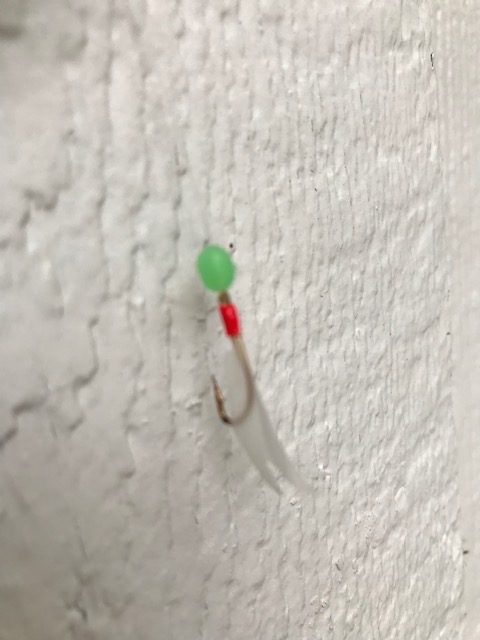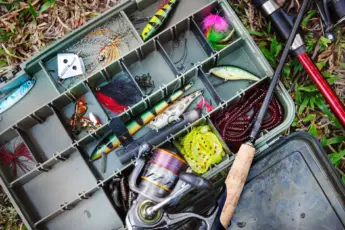The most effective and popular method for catching baitfish from an elevated position over the water in Georgia, South Carolina, and North Carolina is dropping a sabiki rig. Sabikis are multiple hook rigs capable of catching a multitude of bait in one drop. Anglers store sabikis in tackle boxes and tie them to the end of the rod when the bait is either visible or invisible. Anglers face challenges with the rigs because of the abundance of hooks strung across a lengthy leader line. Here is what you need to know about a sabiki rig.
What Does A Sabiki Rig Look Like
Sabikis are long rigs because they incorporate between six and ten hooks along their entirety to catch multiple baits in one drop. The rig measures between five and seven feet in length.
The leader line contains a barrel swivel ad the upper portion a snap swivel at the bottom. The mainline connects to the top while a weight snaps to the bottom.
Like a chicken rig, six to ten hooks are extended outward between four and six inches from the center where the mainline and weight are attached. At the end of the branches are hooks. The hooks vary in size based on the type and weight of the baitfish they are chasing.
The hooks look almost identical to a fly. Sabiki hooks come in multiple colors but, most importantly, contain a section of iridescent film. The film’s flash attracts fish and draws them to strike the hook.
What Is A Sabiki Rig Used For
The sabiki rig is designed to catch multiple baitfish when dropped from a boat, pier, dock, or other structure elevated above the water. A sabiki, when deployed, are gently bounced, causing the iridescent film to radiate light emitted from the sun, boat, or dock lighting.
Take into consideration the number of hooks on a single rig. It is not uncommon for anglers to connect to a baitfish on all hooks during a single drop. The faster the baitwell is filled, the sooner the angler can target gamefish with the fresh and live baitfish.
Do You Put Bait On A Sabiki Rig
While sabiki rigs will catch fish without bait, they are more effective when tipped with a tiny piece of shrimp, squid, or fish.
Remember, the bait must be small as the mouths of baitfish are incapable of eating the hook and bait when it is too large.
We have fished sabikis with and without bait. We fill the baitwell far more quickly when the sabiki is baited before sending it over the side in an attempt to catch baitfish.
Remember, when it comes to how to fish a sabiki rig, bounce the rig up and down by raising and lowering the tip. However, ensure the movement is small but rapid to achieve more strikes from baitfish.
How Effective Are Sabiki Rigs
Sabiki rigs are incredibly effective at catching baitfish. While cast nets are also effective, there is greater room for error.
Anglers casting nets must have a visual on bait before throwing, and the throw must be accurate, or the school will become spooked and disperse.
Sabikis, on the other hand, do not require the angler to see the bait however, more times than not, they will. Simple tie a sabiki, drop, and bounce. Avoid pulling the rig up with one bait connected. Wait until multiple baitfish are on the line.
What Kind Of Freshwater and Saltwater Baitfish Bite Sabiki Rigs
Many people ask what can you catch with a sabiki rig. An abundance of fresh and saltwater baitfish readily strike sabiki rigs. Below is the variety of fish.
Saltwater
The most common saltwater catches include goggle eyes, pilchards, herring, ballyhoo, and more.
Check out the best sabiki rigs, which are perfect for catching pilchards and ballyhoo in Georgia, South Carolina, and North Carolina.
Freshwater
In freshwater, drop a sabiki for batfish. A sabiki rig freshwater will catch minnows, shiners, and bream fish. However, they are equally as effective at catching crappie and bluegill.
We do not recommend fishing a sabiki beneath a betts float a bubble style bobber as it will not be nearly as effective.
Can You Catch Big Fish On A Sabiki Rig
While sabikis can be used to catch big fish, the intended use is to load up on baitfish, which captures gamefish.
Catching big fish on a sabiki, requires rig sizes ranging between fourteen and twenty-two. Anything smaller will lead to break-offs and destroy the rig.
Can You Use A Sabiki Rig In Freshwater
Yes, sabiki rigs are used in freshwater, but they were intended for saltwater use. Anglers catch freshwater baitfish and gamefish by dropping and bouncing sabiki rigs.
In some instances, freshwater anglers swear by them. The rig is dropped for bass, perch, striped bass, crappie, bluegill, and more.
Jigging with a sabiki rig is highly effective for white perch and is widely used by anglers. The sabiki rig for perch is used in fresh and brackish waters. The white perch is an anadromous species.
What Does Sabiki Mean In Japanese
When it comes to sabiki meaning, Sabiki is a term and method for catching baitfish. The creation of the bait catching device was in Japan. The sabiki became extremely popular due to its effectiveness and was spread worldwide. Anglers in the United States use the rig in frequency when needing baitfish for a day of inshore or offshore fishing.
Are You Ready To Fish With A Sabiki Rig
Now you know what is a sabiki rig. When fishing in fresh or saltwater in Georgia, North Carolina, or South Carolina, next time you require bait, bring along a sabiki rig. The rigs take practice to handle and avoid becoming stuck because of the abundance of hooks. Watch for oyster shells or other objects as a rig quickly becomes lost when snags are present. Lastly, purchase a saltwater or freshwater fishing license depending on your location before dropping a sabiki rig.






